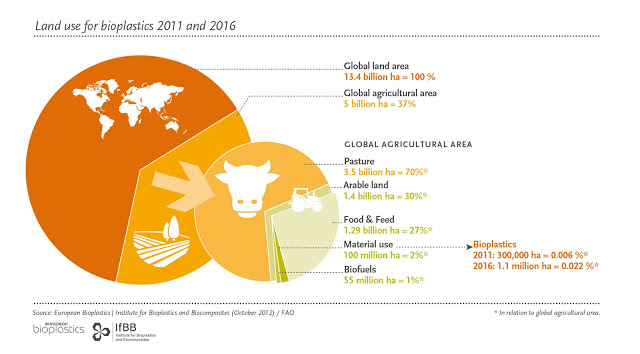You probably noticed by now that the blog has a make-over as it prepares for its own “commercial start-up” of sorts. Stay tuned for that. In the meantime, here is a report from the European Bioplastics stating that approximately only 300,000 hectares of land worldwide was use in 2011 to grow feedstock for bioplastic manufacture, an equivalent of 0.006 percent in relation to the global agricultural area of 5bn hectares.
According to the organization, this is akin to placing a cherry tomato next to the Eiffel Tower. The European Bioplastics market data depicts production capacities of 1.2m tonnes worldwide in 2011.
The land-use data was based from the Food and Agriculture Organization of the United Nations (FAO) and calculations of the Institute for Bioplastics and Biocomposites (IfBB) based in University Hannover, Germany.
Why the study for this? It is because the bio-based chemicals market is being caught up in the tangled debate of Food Vs Fuel, and despite the miniscule use of ag feedstock for bio-based chemicals manufacture such as corn, vegetable oils, sugarcane, etc., consumer products companies down in the supply chain would prefer their bio-based chemicals and materials usage to be as sustainable as possible — that means their raw materials will not compete with food.
According to the study, 27% of the 5bn hectare arable land worldwide are used to grow crops for food and feed, 2% to grow crops for materials (including the share used for bioplastics) and 1% to grow crops for biofuels. I would have thought that crops for biofuels are much bigger than crops for materials….
Anyway, increasing the efficiency of feedstock and agricultural technology is said to be the key in assuring the balance between land-use for bioplastics and for food/feed. In fact, from what I’ve been hearing in several past press releases from various renewable chemical companies, steps are already being taken to develop the use of biomass and other waste-based, non-food feedstock to manufacture several bio-based monomers.
These developments will further shrink the use of agriculture land for bioplastic manufacturing in the future.
Speaking of land and bioplastic, it is also important as part of a bioplastic product’s sustainable life cycle to minimize occupying land for its end-of-life stage. That means a bioplastic product should either be recyclable (cradle-to-cradle) or completely biodegradable (cradle-to-gate).
Polylactic acid (PLA)-based plastic products are constantly being scrutinized and challenged for not being recyclable enough (PLA is said to be incompatible for recycling with other petroleum-based plastics) or not biodegradable enough in landfills.
Major PLA producer NatureWorks published last year a peer-reviewed article on the journal of Polymer Degradation and Stability stating that its Ingeo PLA-based biopolymer is stable enough in landfill and does not released methane in statistically significant quantity.
“We work with a cradle-to-cradle approach to zero waste. What this means in terms of landfill diversion, for example, is ideally that Ingeo foodservice ware would be composted in order to enable the landfill diversion of a food-residual stream, and that Ingeo resins and fibers would be mechanically or chemically recycled and not landfilled.
However, these systems are still emerging and developing. The reality today is that a percentage of Ingeo products end up in landfills. And now we can say with certainty that the environmental impact of that landfilling, in terms of greenhouse gas release, is not significant.” – NatureWorks
NatureWorks said it is constantly looking at a 360-degree sustainability angle — from sustainable agricultural practices in growing feedstock to facilitating sustainable end-of-life scenario for Ingeo bioplastic and fiber.
FOLLOW ME ON THESE SPACE
Discussion
Comments are closed.